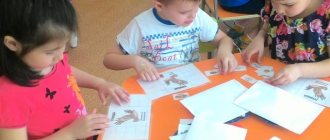Card index of household and household work of preschool children
Content
Card index: Household work in the senior group.
Card No. 1.
“Order in the closet with toys and manuals”
Goal: to teach children to independently and aesthetically arrange toys and aids, maintain order in closets, and wipe dust. Develop hard work and the ability to see disorder. To cultivate aesthetic taste and the desire to work for the benefit of others.
Card No. 2.
"Clean window sills"
Goal: to teach children to observe hygienic skills when working with water: roll up their sleeves, wet a cloth and wring it dry, rinse when dirty. Develop labor skills and habits, accuracy when working with water. Cultivate a desire to work in a team, in harmony.
Card number 3.
"Helping the nanny"
Goal: To teach how to make bed linen and to teach children to provide all possible assistance to adults. Develop hard work and a desire to help adults. Foster respect for the work of adults.
Card number 4.
"Dining duty"
Goal: independently and conscientiously perform the duties of a duty officer; wash your hands thoroughly, put on the clothes of the person on duty, set the table correctly, remove the dishes after eating; brush off tables and sweep the floor. Develop labor skills and abilities, the ability to see disorder in the table setting. Cultivate a desire to work for the benefit of others.
Card number 5.
"Class Duty"
Goal: independently and conscientiously perform the duties of an attendant: lay out materials and aids prepared by the teacher for the lesson on tables; wash and put them away after class. Develop hard work and a desire to help adults. Cultivate a desire to work for the benefit of others.
Card number 6.
"Order in toys"
Goal: to teach children to put on work aprons before starting work; keep toys in order: wash, dry, wipe and put in place. Develop hard work and the ability to see disorder; be careful when working with water. Cultivate a desire to work for the benefit of others.
Card number 7.
"We wash napkins"
Goal: teach children the skills of soaping, rinsing and wringing out napkins, continue to build a work culture
(neatness in the process of activity)
Develop hard work and the ability to see disorder; be careful when working with water. Cultivate a desire to work in a team, in harmony.
Card number 8.
“Order in the dressing room closet (together with the assistant teacher)”
Goal: to teach children to maintain order in their personal wardrobes: empty the closet of clothes and shoes, wipe the shelves with a damp cloth, and neatly put the clothes back in place. Develop diligence, the ability to see disorder, and accuracy when working with water. Cultivate a desire to work in a team, in harmony.
Card number 9.
"Book Repair"
Goal: to teach children to peck at books, use glue and scissors correctly, and use napkins.
Develop labor skills, eye, fine motor skills, creative imagination. Foster a desire to work for the benefit of others, treat books and toys with care.
Card number 10.
"Clean chairs"
Goal: to teach children to help the nanny keep the chairs in the group room tidy and clean: wipe them with a damp cloth; arrange in places after classes. Develop labor skills and abilities, the ability to comply with cultural and hygienic requirements when working. Cultivate a desire to help adults and respect for their work.
Card number 11.
"Washing Doll Clothes"
Goal: To teach children to help the teacher in washing doll clothes and bedding: to teach children to put on work aprons before starting work; prepare the necessary supplies for washing and drying, as well as a workplace; know how to use soap. Develop labor skills and abilities, the ability to comply with cultural and hygienic requirements when working. Cultivate a desire to work for the benefit of others.
Card number 12.
"Washing my combs"
Goal: To teach children to help the teacher in washing combs: rinse soaked combs, clean them with brushes. Develop diligence, the ability to see disorder, and accuracy when working with water.
Cultivate a desire to help adults and respect for their work.
infourok.ru
File of work assignments for children of senior preschool age
Alexandra Alekseeva
File of work assignments for children of senior preschool age
File of work orders
for children of senior preschool age
Task No. 1
"Watering indoor plants"
.
Goal: to expand children’s about the needs of plants for light and moisture, to teach how to recognize moisture-loving and drought-resistant, light-loving and shade-tolerant plants by their leaves. Develop accuracy when working with water and plants, confidence in your actions, work skills . Foster a caring attitude towards the natural environment and a desire to take care of it.
Task No. 2
"Washing houseplants"
.
Purpose: to give children an idea of watering methods (in a tray, under leaves)
and rules
(do not flood, water evenly)
;
cultivate a desire to care for plants. Involve children in all possible help , clarify children’s about indoor plants.
Task No. 3
“Spraying indoor plants with water from a spray bottle”
.
Goal: teach a new work skill ; reinforce children’s that leaves also need moisture; cultivate a caring attitude towards plants. Teach children to independently determine the need for watering (by the color and condition of the soil, by the appearance of the plant, recall the watering technique.
Task No. 4
“Green landing on indoor plants”
(remove diseased leaves, fertilize)
.
Goal: to teach children to determine by the condition of indoor plants what actions are necessary to care for them (watering, cleaning, loosening, fertilizing, correctly perform the relevant labor operations , invite the children to tell about the purpose of each of them.
Task No. 5
"Taking care of plants"
.
Goal: to clarify previously acquired knowledge about ways to keep plants clean, to teach children how to choose a method for removing dust from a plant, focusing on the features of its appearance and structure.
Task No. 6
“Loosening the soil of indoor plants”
.
Goal: teach children to care for indoor plants; give children knowledge about why it is necessary to loosen the soil of plants; consolidate loosening techniques and rules for using the necessary items for this. Develop labor skills , accuracy. Foster an ecological culture and respect for the environment.
Task No. 7
"Feeding plants"
.
Goal: to tell children about the need to feed plants, based on children’s that the source of nutrition for plants is the soil, and that gradually, by giving nutrients to plants, the soil is depleted. Show how to fertilize plants.
Task No. 8
"Washing pallets"
.
Goal: to teach children to do work independently and responsibly, distribute responsibilities, and coordinate actions.
Task No. 9
"Transplanting indoor plants"
.
Goal: to expand children’s understanding of the labor involved in caring for plants of various types: to learn how to replant indoor plants. Introduce children to the sequence and technique of work, the rules of personal hygiene, and offer to provide all possible assistance to the teacher.
Task No. 10
"Planting Onions"
.
Goal: to teach children to set a goal, prepare a workplace, tools and clean up after themselves. To consolidate children's knowledge about the structure of the onion , about the conditions necessary for onion growth. Develop labor skills and habits , accuracy when working with land, water and plants. Foster an environmental culture, a desire to achieve results, and participate in a common cause.
Task No. 11
"Planting pea seeds"
.
Goal: invite children to tell how a plant grows from a seed, clarify and supplement the children’s . To update and specify ideas about the conditions necessary for the growth of peas.
Task No. 12
“Sowing seeds of flowers and vegetables”
.
Goal: to give children knowledge that every plant has seeds. Teach the sequence of actions required when sowing seeds: make a hole in the ground (to sow seeds, each time marking the distance between them and the grooves with a stick); teach to observe cultural and hygienic skills when working. To consolidate children's knowledge about at what time, which seeds are sown in boxes in a group for preparing seedlings, and which seeds are sown in open ground. Develop labor skills and abilities . Foster an ecological culture, a caring attitude towards the natural environment, and a desire to take care of it.
Task No. 13
“Planting seedlings, caring for them”
.
Goal: to form children’s about the main stages of plant growth and development (seed, seedling, stem with leaves)
;
about the basic methods of growing plants and caring for them (planting in loose soil, watering, loosening the soil, weeding, feeding). Be careful when planting seedlings, as the plants are very fragile. Develop labor skills and habits , accuracy when working with land, water and plants.
Foster an ecological culture, a caring attitude towards the natural environment, and a desire to take care of it. Task No. 14
"Dining duty"
.
Goal: to teach children to independently and conscientiously perform the duties of a duty officer. Wash your hands thoroughly, put on the duty officer's clothes, and set the table correctly. Clear dishes after meals. Develop labor skills and abilities , the ability to see disorder in the table setting. Foster a desire to work for the benefit of others .
Task No. 15
“Duty in the educational activity zone”
Goal: independently and conscientiously fulfill the duties of the duty officer: lay out on the tables materials and aids prepared by the teacher for the lesson; wash, if necessary, put them back in place after class.
Task No. 16
“We will prepare equipment and materials for educational activities”
.
Goal: develop a sense of responsibility for the assigned task , teach children to carefully lay out materials and equipment for educational activities.
Task No. 17
Remove plasticine and modeling boards.
Goal: to develop teamwork skills
Task No. 18
“Learning to make our beds”
.
Goal: to bring to the awareness of children how to properly make the bed; cultivate independence, accuracy, and the desire to help adults. Foster a responsible attitude towards self-care work and independence.
Task No. 19
“Assisting the junior teacher in laying out bedding on the beds.”
Goal: to teach how to sort bed linen according to their belongings, to cultivate a desire to help the junior teacher and respect for other people’s work . Cultivate a desire to work , a sense of responsibility for the assigned work .
Task No. 20
"Changing dirty towels"
.
Goal: maintain a steady interest in work , the desire to diligently complete the assignment . Learn to hang a towel in an individual compartment. Foster a desire to work and help adults .
Task No. 21
"Order in the dressing room closet"
(together with the junior teacher)
Goal: to teach children to maintain order in their personal wardrobes: empty the closet of clothes and shoes, wipe the shelves with a damp cloth, and neatly put the clothes back in place. Develop diligence , the ability to see disorder, and accuracy when working with water. Cultivate a desire to work together in a team .
Task No. 21
"Washing chairs"
.
Goal: to teach children to help the junior teacher, to keep the chairs in the group room tidy and clean: wipe them with a damp cloth; put in place. Develop labor skills and abilities , the ability to comply with cultural and hygienic requirements when working. Foster a desire to help adults and respect for their work .
Task No. 22
"Washing building materials"
.
Goal: to teach how to wash, dry and lay building materials, to teach children to constantly and promptly maintain order in the play corner, to wash building materials with a soapy solution prepared by the teacher, to rinse and dry them; observe the rules of personal hygiene.
Task No. 23
Wet cleaning of modules for construction.
Goal: to develop teamwork skills .
Task No. 24
“We wipe the dust off the shelves for games and toys”
.
Goal: continue to teach children to wipe dust from shelves with a damp cloth. Develop labor skills and abilities . To cultivate aesthetic taste and the desire to work for the benefit of others .
Task No. 25
“Cleaning up order in the group after the game”
.
Goal: to form in children a conscious desire for order, the habit of putting away toys after playing. Improve the ability to draw up a work plan and select the necessary materials for upcoming activities.
Task No. 26
"Order in toys"
Goal: to teach children to put on work aprons before starting work; to keep toys in order: wash, dry, wipe and put in place. Develop diligence , the ability to see disorder; be careful when working with water. Cultivate respect for your own work and the work of others .
Task No. 27
"Washing Dolls"
.
Goal: to teach children to help the teacher in washing dolls: rinse soaked dolls, clean them with brushes. Develop diligence , the ability to see disorder, and accuracy when working with water. Foster a desire to help adults and respect for their work .
Task No. 28
Maintain the appearance of the dolls: select clothes, comb, tie a bow.
Goal: to foster a sense of satisfaction from the work done.
Task No. 29
"Washing doll's clothes"
.
Goal: to teach children to help the teacher in washing doll clothes and bedding. Teach children to put on work aprons before starting work; prepare the necessary supplies for washing and drying, as well as a workplace; know how to use soap. Develop labor skills and abilities , the ability to comply with cultural and hygienic requirements when working. Foster a desire to work for the benefit of others .
Task No. 30
“Washing napkins used for visual arts”
.
Goal: to teach children the skills of soaping , rinsing and wringing out napkins, to continue to form a work (tidiness in the process of work)
.
Task No. 31
"Keeping your manual closet tidy"
.
Goal: to teach children to organize manuals on their own, maintain order in closets, and wipe dust.
Task No. 32
“We wipe the window sills with a damp rag in the group room and bedroom”
.
Goal: to teach children to follow the following rules when working with water: roll up their sleeves, wet a cloth and wring it dry, and rinse it in water when it gets dirty.
Task No. 33
"Cleaning up building material"
.
Goal: to teach how to wash, dry and lay building materials, to teach children to constantly and promptly maintain order in the play area, to wash building materials with a soapy solution prepared by the teacher, to rinse and dry them; observe the rules of personal hygiene.
Task No. 34
"Cleaning the play area"
.
Goal: to teach children to put on work aprons before starting work; keep toys in order, wash them, dry them, wipe them and put them in place.
Task No. 35
“Let’s arrange the chairs in a certain order.”
.
Goal: continue to develop labor skills ; carry out the assignment carefully , quickly, diligently .
Task No. 36
"Repair of boxes for waste material"
.
Goal: to consolidate technical skills in working with scissors and glue, cultivate frugality, and the ability to work collectively.
Task No. 37
"Work in the book corner"
.
(book restoration)
.
Goal: to teach children to choose books that need repair, carefully glue them (use glue and scissors correctly, use napkins)
.
Cultivate a caring attitude towards books, a desire to work , and maintain order.
Task No. 38
“Work in the book corner: we help repair books from the library of the junior group.”
Goal: invite children to help repair children's books. Cultivate a caring attitude toward books and mutual assistance. Develop and teach how to use book repair skills.
Task No. 39
“We have a tidy closet”
.
Goal: to teach children to be careful when folding things in a coat closet.
Task No. 40
“General cleaning in a group room”
.
Goal: invite children to carefully examine the group room and determine what needs to be done to put things in order; Together with the teacher, outline a work plan. Learn to organize joint work . Create responsibility for fulfilling instructions
Card index: Household work in the senior group.
Card index: Household work in the senior group.
Card No. 1.
“Order in the closet with toys and manuals”
Goal: to teach children to independently and aesthetically arrange toys and aids, maintain order in closets, and wipe dust. Develop hard work and the ability to see disorder. To cultivate aesthetic taste and the desire to work for the benefit of others.
Card No. 2.
"Clean window sills"
Goal: to teach children to observe hygienic skills when working with water: roll up their sleeves, wet a cloth and wring it dry, rinse when dirty. Develop labor skills and habits, accuracy when working with water. Cultivate a desire to work in a team, in harmony.
Card number 3.
"Helping the nanny"
Goal: To teach how to make bed linen and to teach children to provide all possible assistance to adults. Develop hard work and a desire to help adults. Foster respect for the work of adults.
Card number 4.
"Dining duty"
Goal: independently and conscientiously perform the duties of a duty officer; wash your hands thoroughly, put on the clothes of the person on duty, set the table correctly, remove the dishes after eating; brush off tables and sweep the floor. Develop labor skills and abilities, the ability to see disorder in the table setting. Cultivate a desire to work for the benefit of others.
Card number 5.
"Class Duty"
Goal: independently and conscientiously perform the duties of an attendant: lay out materials and aids prepared by the teacher for the lesson on tables; wash and put them away after class. Develop hard work and a desire to help adults. Cultivate a desire to work for the benefit of others.
Card number 6.
"Order in toys"
Goal: to teach children to put on work aprons before starting work; keep toys in order: wash, dry, wipe and put in place. Develop hard work and the ability to see disorder; be careful when working with water. Cultivate a desire to work for the benefit of others.
Card number 7.
"We wash napkins"
Goal: teach children the skills of soaping, rinsing and wringing out napkins, continue to build a work culture
(neatness in the process of activity)
Develop hard work and the ability to see disorder; be careful when working with water. Cultivate a desire to work in a team, in harmony.
Card number 8.
“Order in the dressing room closet (together with the assistant teacher)”
Goal: to teach children to maintain order in their personal wardrobes: empty the closet of clothes and shoes, wipe the shelves with a damp cloth, and neatly put the clothes back in place. Develop diligence, the ability to see disorder, and accuracy when working with water. Cultivate a desire to work in a team, in harmony.
Card number 9.
"Book Repair"
Goal: to teach children to peck at books, use glue and scissors correctly, and use napkins.
Develop labor skills, eye, fine motor skills, creative imagination. Foster a desire to work for the benefit of others, treat books and toys with care.
Card number 10.
"Clean chairs"
Goal: to teach children to help the nanny keep the chairs in the group room tidy and clean: wipe them with a damp cloth; arrange in places after classes. Develop labor skills and abilities, the ability to comply with cultural and hygienic requirements when working. Cultivate a desire to help adults and respect for their work.
Card number 11.
"Washing Doll Clothes"
Goal: To teach children to help the teacher in
profhelp.net
Card index for the senior group: “Household work”
Card index for the senior group:
"Household labor."
Card No. 1
.
“Order in the closet with toys and manuals”
Target:
teach children to independently and aesthetically arrange toys and aids, maintain order in closets, and wipe dust.
Develop hard work
and the ability to see disorder.
To cultivate aesthetic taste and the desire to work for the benefit of others
.
Card No. 2
.
"Clean window sills"
Target:
teach children to observe hygienic skills when working with water: roll up their sleeves, wet a cloth and wring it dry, rinse when dirty.
Develop labor skills
, accuracy when working with water.
Cultivate a desire to work in a team
, in harmony.
Card No. 3
.
"Helping the nanny"
Target:
Learn to make bed linen and teach children to provide all possible assistance to adults.
Develop hard work
and a desire to help adults.
Foster respect for the work of adults
.
Card No. 4
.
"Dining duty"
Target
: independently and conscientiously perform the duties of a duty officer;
wash your hands thoroughly, put on the clothes of the person on duty, set the table correctly, put away the dishes after eating; brush off tables and sweep the floor. Develop labor skills and abilities
, the ability to see disorder in the table setting.
Foster a desire to work for the benefit of others
.
Card No. 5
.
"Class Duty"
Target:
independently and conscientiously perform the duties of an attendant: lay out materials and aids prepared by the teacher for the lesson on tables;
wash and put them away after class. Develop hard work
and a desire to help adults.
Foster a desire to work for the benefit of others
.
Card No. 6
.
"Order in toys"
Target:
teach children to put on work aprons before starting work;
keep toys in order: wash, dry, wipe and put in place. Develop diligence
, the ability to see disorder;
be careful when working with water. Foster a desire to work for the benefit of others
.
Card No. 7
.
"We wash napkins"
Target:
teach children the skills of soaping, rinsing and wringing out napkins, continue to form a
work
(tidyness in the process of work)
Develop hard work
, the ability to see disorder;
be careful when working with water. Cultivate a desire to work in a team
, in harmony.
Card No. 8
.
“Order in the dressing room closet (together with the assistant teacher)
»
Target:
teach children to maintain order in their personal wardrobes: empty the closet of clothes and shoes, wipe the shelves with a damp cloth, and neatly put the clothes back in place.
Develop diligence
, the ability to see disorder, and accuracy when working with water.
Cultivate a desire to work in a team
, in harmony.
www.prodlenka.org
Features of work assignments
Labor orders have their own characteristics:
- A work assignment is given to an adult child. At preschool age, children are capable of completing tasks emanating from an adult;
- Any order has a specific purpose and tasks that must be resolved through its implementation;
- Labor assignments have a clearly established focus on achieving a specific performance result;
- Work assignments are easy to monitor their implementation and coordinate the child’s actions during the execution of the assignment;
- Work assignments develop children’s skills in finishing what they start;
- Work assignments contain a demanding component, which develops the child’s purposeful actions;
- Work assignments develop a business environment in the children's team and develop the labor orientation of their life.




